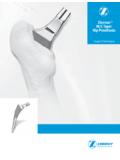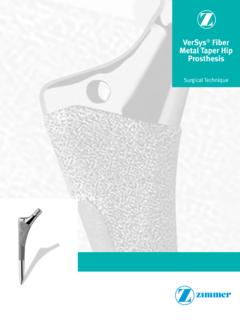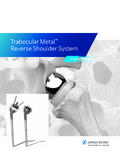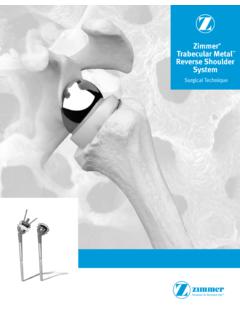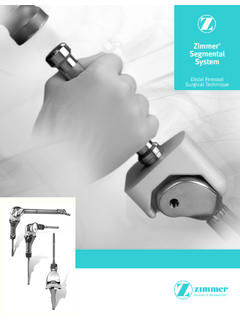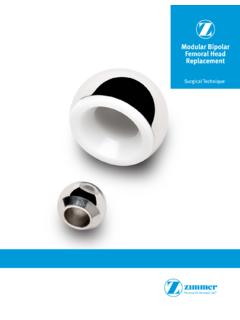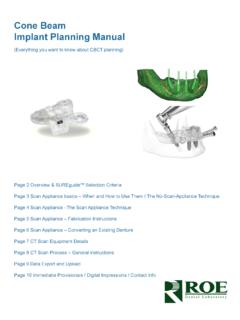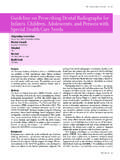Transcription of Anatomical Shoulder™ Domelock® System …
1 AnatomicalShoulder domelock SystemSurgical TechniqueAnatomical shoulder domelock System Surgical Technique3 Table of ContentsIndication/Contraindication 4 Precise Variable Reproducible Simple 5 Key Surgical Steps 6 Surgical Techniques 8 Anatomical shoulder domelock Surgical Technique Steps Preoperative Templating 8 Patient Positioning and Exposure 9 1. Humeral Head Identification, Preparation and Resection 102. Humeral Stem Size Preparation and Determination 143. Head Size Determination, Orientation and Fixation 174. Head Preparation and Implantation 22 Optional Further Combination Possibilites 26 Postoperative Treatment 31 All shoulder solution possibilities by article number can be found at the Zimmer shoulder Solutions - Catalogue : shoulder domelock System Surgical TechniqueIndication/ContraindicationInte nded UseThe Anatomical shoulder System is intended for long-term implantation into the human shoulder joint in primary or revision total or hemi shoulder arthroplasty.
2 The System is intended to help relieve pain and to help restore function in patients with adequate bone stock to support the : The Anatomical shoulder domelock System is indicated for Advanced wear and tear of the shoulder joint resulting from degenerative, posttraumatic or rheumatoid arthritis Avascular necrosis Conditions consequent to earlier operations Omarthrosis Revision of shoulder prosthesisThe Humeral Stems Cemented are intended for cemented use and the Humeral Stems Uncemented are intended for uncemented use. When used in a total shoulder application, the Anatomical shoulder Pegged and Keeled Glenoids Cemented are intended for cemented use : Patient s physical conditions that would impair adequate implant support and/or prevent the use of an appropriately sized implant, , previous surgery, insufficient quality or quantity of bone, neuromuscular compromise or vascular deficiency in the affected limb in sufficient degree to endanger the success of the interven-tion , absence of musculoligamen-tous supporting structures, joint neuropathy or other conditions that may lead to inadequate skeletal fixation.
3 Signs of infection Severe instability secondary to advanced loss of osteochondral structure Charcot s shoulder (neuroarthropathy) Complex 3 and 4 part fractures of the proximal humerusAnatomical shoulder domelock System Surgical Technique5 For primary and revision every Anatomical shoulder Humeral Stem allows the shoulder Humeral Stem allows the Shouldercombination with the regular Humeral Heads or with the Reverse position between Humeral Stem and Humeral Head in the Anatomical shoulder domelock System is entirely shoulder domelock System is entirely shoulder Domelockindependent and variable, designed to allow for an anatomically Anatomical shoulder Domelockarthroplasty System uses a straightforward timesaving surgical technique that aims to enable placement of the device in just a few steps saving valuable OR time without compromising functional designed to adapt to given anatomyThe Anatomical shoulder domelock arthroplasty System aims to offer an Anatomical shoulder joint reconstruction which is designed to adapt to the given patient anatomy without procedural complexity, to help recover the normal kinematics for which the body has adapted.
4 This includes the normal joint center, muscle moment arms, ligament positions, and loading to improve functional of the long term care of the patient is essential. The Anatomical shoulder Humeral Stem, by virtue of its shoulder Humeral Stem, by virtue of its Shoulderdesign, should enable future optionsfor revision or upgrade to a reverse solution, by using the same stem, therefore no stem removal should be shoulder domelock Instrument Variable Reproducible SimpleHumeral HeadHumeral HeadDomelock (Ball-taper, Dome and taper, Dome and Expansion Cone)Humeral Stem6 Anatomical shoulder domelock System Surgical TechniqueKey Surgical Steps1. Humeral Head Identification, Preparation and Resection2.
5 Humeral Stem Size Preparation and DeterminationAnatomical shoulder domelock System Surgical Technique73. Head Size Determination, Orientation and Fixation 4. Head Preparation and Implantation8 Anatomical shoulder domelock System Surgical TechniquePreoperative TemplatingPreoperative evaluation of the humerus using the Anatomical shoulder help determine the size of the prosthesis and level of the head goal is to make a resection that matches the anatomy of the templates:X-Ray Templates for Anatomical shoulder Cemented Stems, REF Templates for Anatomical shoulder Uncemented Stems, REF Templates for Anatomical shoulder Fracture Stems, REF Templates for Anatomical shoulder domelock Heads, REF shoulder domelock System Surgical Technique9 Initial IncisionThe incision should start in front of the AC joint 1 to 2cm lateral from the tip of coracoid running straight downwards to the humeral delta insertion (Fig.)
6 2).Patient PositioningThe patient should be placed in a beach chair position on the edge of the operating table (Fig. 1). The target shoulder should extend laterally over the edge of the table so the arm can be brought into full extension and adduction. An armrest is upper part of the operating table has to be open to allow shoulder extension ( shoulder table).Fig. 1 Fig. 2 Patient Positioning and Exposure10 Anatomical shoulder domelock System Surgical Technique1. Humeral Head Identification, Preparation and ResectionWith the humeral head fully exposed remove any unwanted osteophytes to restore the humerus to near native anat-omy. The humeral head should be resected exactly at the level of theanatomical humeral head resection techniques are possible with Anatomical shoulder domelock Instrumentation: a freehandDomelock Instrumentation: a freehandDomelockcut and an alignment guide Supraspinatus resection technique (Fig.
7 3).In the superior and anterior superior aspects, the Anatomical neck corresponds to the insertions of the tendons of the supraspinatus and uppermost section of the subscapularis. In the inferior aspect, there is a smooth transition between the cartilage of the head and the cortical bone of the humerus. In the posterior aspect, in the region of the infraspinatus and teres minor is the sulcus, which is a groove of 6 to 8 mmin length, without cartilage or attached tendons. The resection must start exactly on the cartilage. Note: Do not resect the cartilage-free 3 Fig. 4#1 Fig. 5 Trays and InstrumentsAnatomical shoulder domelock System Surgical Technique11 Fig. 8 Positioning of the Alignment Guide Supraspinatus The superior part of the cut should be at the medial border of the insertion of the supraspinatus tendon #2 (Fig.
8 5). The Kirschner Wire (K-Wire) should exit atthe posterior edge of the cartilage medial to the bare area #1 (Fig. 4). After defining the position, the displaceable part of the Alignment Guide "Supraspinatus can be fixed with the screw #3 (Fig. 5).Place the K-Wire 2x100 mm into the Align-ment Guide Supraspinatus (Fig. 6).Use the Pin Retractor 2 mm to place the the Alignment Guide Supraspinatus .The first K-Wire 2x100 mm, also called "supraspinatus pin", defines the retroversion (Fig. 7 and 8).The Kirschner Wire (K-Wire) should exit atthe posterior edge of the cartilage medial to the bare area #1 (Fig. 4). After defining the position, the displaceable part of the Alignment Guide "Supraspinatus can be fixed with the Place the K-Wire 2x100 mm into the Align-ment Guide Supraspinatus (Fig.
9 6).Use the Pin Retractor 2 mm to place the Fig. 6 Fig. 5#2#3 Fig. 7 Trays and Instruments12 Anatomical shoulder domelock System Surgical TechniqueThe Resection Guide is mounted over the 1st K-Wire (Fig. 9), the Supraspinatus- Pin which identifies the angle identificationAlign the position of the 2nd K-Wire by identifying the correct inclination angle. Due to patient requirements, there are2 mm K-Wires in 100 mm and 70 mm Supraspinatus attachment will additionally guide you laterally. Use the Pin Retractor 2 mm to place the additional K-Wires as per 3rd and 4th K-Wire to your requirements (Fig. 11 and 12).Use the Pin Retractor 2 mm to place the Resection Guide is mounted over Supraspinatus- Pin which identifies Set additional K-Wires as per 3rd and 4th to place the Fig.
10 9 Fig. 10 Fig. 112nd K-Wire3rd K-Wire1st K-WireTrays and InstrumentsAnatomical shoulder domelock System Surgical Technique13 Resect the Humeral Head, guided by Resection Guide and K-Wires (Fig. 13 and 14).Note: Do not use a saw blade with downward facing teeth. Remove the Resection Guide and K-Wires, clean the resection again the Pin Retractor 2 : For TSA (Total shoulder Arthroplasty) please continue with the Anatomical shoulder GlenoidAnatomical shoulder GlenoidAnatomical shoulder Surgical Technique, : the Humeral Head, guided by Resection Guide and K-Wires Do not use a saw blade with downward facing teeth. Remove the Resection Guide and K-Wires, clean the resection 12 Fig. 13 Fig. 144th K-WireTrays and Instruments14 Anatomical shoulder domelock System Surgical TechniqueBegin insertion of the reamer just under the highest point of the resection, directly medial to the bicipital tendon (Fig.)

